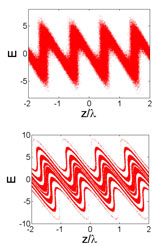
Handy Links
SLAC News Center
SLAC Today
- Subscribe
- Archives: Feb 2006-May 20, 2011
- Archives: May 23, 2011 and later
- Submit Feedback or Story Ideas
- About SLAC Today
SLAC News
Lab News
- Interactions
- Lightsources.org
- ILC NewsLine
- Int'l Science Grid This Week
- Fermilab Today
- Berkeley Lab News
- @brookhaven TODAY
- DOE Pulse
- CERN Courier
- DESY inForm
- US / LHC
SLAC Links
- Emergency
- Safety
- Policy Repository
- Site Entry Form

- Site Maps
- M & O Review
- Computing Status & Calendar
- SLAC Colloquium
- SLACspeak
- SLACspace
- SLAC Logo
- Café Menu
- Flea Market
- Web E-mail
- Marguerite Shuttle
- Discount Commuter Passes
-
Award Reporting Form
- SPIRES
- SciDoc
- Activity Groups
- Library
Stanford
Around the Bay
Crafting Coherence
With experimentalists just beginning to reveal the ultrafast secrets of atoms and molecules in motion with the Linac Coherent Light Source, researchers at SLAC are already working on the next generation of X-ray free electron laser. Building on theoretical work by SLAC beam theorist Gennady Stupakov, the Echo-7 experiment will test a new way to produce an X-ray beam with an important characteristic not found in today's X-ray lightsources.
"The idea behind this new scheme is to improve the quality of the beam," said Stupakov. "The beam in a self-amplified spontaneous emission free electron laser is excellent, but we would like to add an important quality: temporal coherence."
The X-ray beam created by a self-amplified spontaneous emission, or SASE, free-electron laser—like the Linac Coherent Light Source at SLAC, the [upcoming] XFEL at DESY and the SPring-8 Compact SASE Source at SPring-8—has high spatial coherence, meaning that the signals at different points in space are highly correlated. But such a laser beam does not have high temporal coherence, meaning that the beam consists of many chaotic spikes instead of a well-defined, smooth shape over time. Such is the nature of these new SASE machines.
In February of this year, Stupakov published a paper in which he envisioned echo-enabled harmonic generation, or EEHG, a process by which researchers could create a free electron laser with both types of coherence. To do this, an electron beam would need to interact with a "seed" laser that already has temporal and spatial coherence, albeit with a longer wavelength than the researchers ultimately need. Interaction with the seed laser would cause the electrons in the beam to pack into bunches in just the right pattern to later generate temporally and spatially coherent X-ray light. A SASE free-electron laser, in comparison, begins not with a seed laser but with random noise, which leads to its lack of temporal coherence.
Previously, researchers had focused on other, similar methods of generating temporally and spatially coherent X-ray light, including one called high-gain harmonic generation. HGHG, however, is less efficient than EEHG, and allows researchers to generate light with wavelengths only five or six times shorter than that of the seed laser—not yet near the X-ray range. To reach the X-ray range—about 50 times shorter than the wavelength of the seed laser—researchers would have to stack many HGHG modules one after another, which would make the system complicated and sensitive to unwanted jitters.
To test EEHG theory, a team of researchers led by SLAC's Dao Xiang and Carsten Hast will conduct a proof-of-principle experiment at the Next Linear Collider Test Accelerator at SLAC this winter. There, they will first seed the electron beam with a laser, creating the optimal energy pattern—or "modulation"—in the electron bunches. The team will then use an instrument called a chicane to first over-bunch the beam, manipulating it far past the optimal shape and, in effect, smearing the pattern. While this process will almost destroy the pattern, it will also add a complicated fine structure into correlations between the positions and energies of the particles in the beam. The researchers will then bring the pattern back with another laser and chicane, similar to an echo. The result will be a temporally and spatially coherent beam with a shorter wavelength than the seed laser.
The technique, Xiang said, is a little daunting because the researchers will first destroy the beam's density modulation before they try to retrieve it.
"This is a very challenging experiment," said Eric Colby, head of SLAC's Advanced Accelerator Research Department. "The trick is to maintain the fine 'phase space' structure while transporting the beam." The experiment has been enabled by the techniques and infrastructure developed as part of the Advanced Accelerator R&D program supported by the DOE Office of High Energy Physics. “We could not be building the Echo-7 experiment without the work on the E-163 laser acceleration experiment and the development of Next Linear Collider Test Accelerator,” noted Eric.
The Echo-7 team, which includes members of SLAC's Beam Physics Department, Test Facilities Department and Advanced Accelerator Research Department as well as Lawrence Berkeley National Laboratory's Center for Beam Physics, will conduct the experiment between January and April of next year.
"With the NLCTA experimental facility, we have the opportunity to do a very rapid experiment that will study some fundamental accelerator physics," said Accelerator Research Division Director and experiment PI, Tor Raubenheimer. "The knowledge and facilities already in existence at this laboratory are fantastic."
The goal of these first experiments is to create a temporally coherent beam with a wavelength a factor of seven shorter than its starting wavelength. This will prove that the technique works and could be scaled to the X-ray range. It could then be used to upgrade an existing SASE free electron laser—like the LCLS—or to simplify the design of a future machine.
"Then the real scientific fun begins," Xiang said.
The Echo-7 experiment is funded by the Department of Energy Office of Science Basic Energy Sciences program and benefits from extensive infrastructure developed by the Office of High Energy Physics.
—Kelen Tuttle
SLAC Today, October 5, 2009
